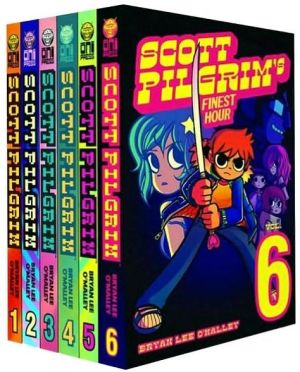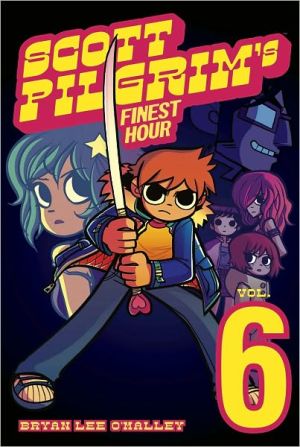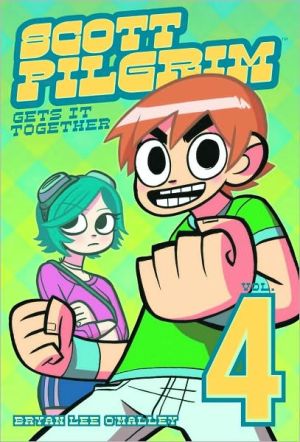Asterios Polyp
The triumphant return of one of comics’ greatest talents, with an engrossing story of one man’s search for love, meaning, sanity, and perfect architectural proportions. An epic story long awaited, and well worth the wait.\ \ Meet Asterios Polyp: middle-aged, meagerly successful architect and teacher, aesthete and womanizer, whose life is wholly upended when his New York City apartment goes up in flames. In a tenacious daze, he leaves the city and relocates to a small town in the American...
Search in google:
The triumphant return of one of comics’ greatest talents, with an engrossing story of one man’s search for love, meaning, sanity, and perfect architectural proportions. An epic story long awaited, and well worth the wait. Meet Asterios Polyp: middle-aged, meagerly successful architect and teacher, aesthete and womanizer, whose life is wholly upended when his New York City apartment goes up in flames. In a tenacious daze, he leaves the city and relocates to a small town in the American heartland. But what is this “escape” really about? As the story unfolds, moving between the present and the past, we begin to understand this confounding yet fascinating character, and how he’s gotten to where he is. And isn’t. And we meet Hana: a sweet, smart, first-generation Japanese American artist with whom he had made a blissful life. But now she’s gone. Did Asterios do something to drive her away? What has happened to her? Is she even alive? All the questions will be answered, eventually.In the meantime, we are enthralled by Mazzucchelli’s extraordinarily imagined world of brilliantly conceived eccentrics, sharply observed social mores, and deftly depicted asides on everything from design theory to the nature of human perception.Asterios Polyp is David Mazzucchelli’s masterpiece: a great American graphic novel.The Barnes & Noble ReviewEven the superior work done by artist David Mazzucchelli on such icons as Batman and Daredevil, and in his graphic transliteration of Paul Auster's novel City of Glass, fails to adequately prepare the reader for the magnificence of his first-ever solo graphic novel, Asterios Polyp. Daring, engaging, insightful, and gripping, this tale intertwines brutality and compassion, arrogance and pity, the quotidian and the ethereal. The eponymous protagonist is a hopeful monster if ever there was one. Just 50, Asterios is a "paper architect," one who's never had any of his concepts reified, and his personal life mirrors his career: all head trip, no outreach. We meet him on the skids, with gracefully interspersed flashbacks revealing his whole sad history. To his own consternation, he allows a chance catastrophe to propel him on a painful journey of self-discovery, repentence, and reconciliation, which culminates in a shocking conclusion. Mazzucchelli's tremendously variegated art pays homage to any number of greats: Los Bros Hernandez, Abner Dean, Will Eisner, Saul Steinberg, David B. all register. But his unique page compositions and the color palette are not imitative but endlessly clever and diverse, as the tale oscillates between naturalistic and fantastical. Cubist touches, cross-hatching, and "clear line" drawing contribute their flavors, and nearly every detail, down to the word balloons, is open to innovation. The character designs themselves are revelatory: the scribble-swirl eyes of Asterios' wife, Hana, betray all her inner confusions. Recurring motifs, such as the lightning bolt that sends Asterios on his quest, provide a sense of rich patterning. Mazzucchelli has layered in depths of visual and prose multiplexity that will reward rereadings in ways that the average graphic novel simply cannot sustain. --Paul DiFilippo
\ Library JournalFans of Building Stories might also enjoy this astoundingly rich comic that traces the life of self-centered architecture professor Asterios Polyp. While Ware works in minute detail, Mazzucchelli draws very large images with sweeping, open panels and color washes in tones of blue, purple, pink, and yellow. As much as they differ visually, they each pay great attention to architecture, the complications of relationships, issues of fulfillment, and the textual and visual play of time and space. The artist is meticulous when it comes to the details of story. His pages seem to overflow with speech bubbles and text outside of panels, with every character’s voice expressed in a different typeface. Every character has a particular color and style as well, which changes based on interactions: Asterios is blue and his wife, Hana, is pink. When they are in sympathy with each other their colors and styles blend, but when they are discordant Asterios becomes various blue shapes and Hana becomes pink hash lines. Time is keyed to color as well. When Asterios begins a new chapter in his life, the pages recounting it are dominated by yellow. When he and Hana reunite after their divorce, she has become green, no longer changing based on his nearness. This brilliant and lovely work should hold deep attraction for fans of Ware.\ (c) Copyright 2011. Library Journals LLC, a wholly owned subsidiary of Media Source, Inc. No redistribution permitted.\ \ \ \ \ \ Douglas Wolk…a big, proud, ambitious chunk of a graphic novel, with modernism on its mind and a perfectly geometrical chip on its shoulder. The tension between formalist rigor and emotional subtlety is not just the theme (and method) of the cartoonist David Mazzucchelli's decade-in-the-making opus; it's basically the plot…Asterios Polyp is a dazzling, expertly constructed entertainment, even as it's maddening and even suffocating at times. It demands that its audience wrestle with it, argue with it, reread and re-examine it.\ —The New York Times Book Review\ \ \ George Gene Gustines…magnificent…Asterios Polyp, which took a decade for Mr. Mazzucchelli to complete, has been well worth the wait. Its ambition jump-starts the future of the graphic novel.\ —The New York Times\ \ \ \ \ Publishers WeeklyFor decades, Mazzucchelli has been a master without a masterpiece. Now he has one. His long-awaited graphic novel is a huge, knotty marvel, the comics equivalent of a Pynchon or Gaddis novel, and radically different from anything he's done before. Asterios Polyp, its arrogant, prickly protagonist, is an award-winning architect who's never built an actual building, and a pedant in the midst of a spiritual crisis. After the structure of his own life falls apart, he runs away to try to rebuild it into something new. There are fascinating digressions on aesthetic philosophy, as well as some very broad satire, but the core of the book is Mazzucchelli's odyssey of style-every major character in the book is associated with a specific drawing style and visual motifs, and the design, color scheme and formal techniques of every page change to reinforce whatever's happening in the story. Although Mazzucchelli stacks the deck-few characters besides Polyp and his inamorata, the impossibly good-hearted sculptor Hana, are more than caricatures-the book's bravado and mastery make it riveting even when it's frustrating, and provide a powerful example of how comics use visual information to illustrate complex, interconnected topics. Easily one of the best books of 2009 already. (June)\ Copyright © Reed Business Information, a division of Reed Elsevier Inc. All rights reserved.\ \ \ \ \ Kirkus ReviewsEven by the standards of the graphic novel, this cosmic epic pushes the creative envelope. With previous credits including superheroes for Marvel Comics and the transformation of Paul Auster's City of Glass into a graphic novel (2004), Mazzucchelli returns with a title that suggests a mid-period Pink Floyd song and an illustrated narrative that is every bit as mind-blowing. It begins with a bolt of lightning that destroys the New York City apartment of the title character, a pompous academic who is celebrated (or who celebrates himself) as a "paper architect." He draws plans for buildings that will never be built, and his theories inform many of the panels, rendering them as the graphic equivalent of metafiction, design about design. For many pages at a stretch there are few or no words, as a single panel might stretch across a page or two. Yet the narrative functions something like memory, flitting from the present-in which Polyp finds work in a small-town auto shop, after losing everything in his apartment fire, and inserts himself within a community that proves surprisingly accommodating-through critical junctures of his past. It seems that Polyp was actually a twin, and that his stillborn brother might be providing narration. He has also somehow married a beautiful, talented, Japanese-American artist named Hana, though something went wrong with the marriage well before the lightning bolt. In this graphic novel of fate, chance and shooting stars, Polyp insists that "I am the hero of my own story," yet the art provides plenty of evidence to the contrary. A visual and even philosophical stunner.\ \ \ \ \ The Barnes & Noble ReviewEven the superior work done by artist David Mazzucchelli on such icons as Batman and Daredevil, and in his graphic transliteration of Paul Auster's novel City of Glass, fails to adequately prepare the reader for the magnificence of his first-ever solo graphic novel, Asterios Polyp. Daring, engaging, insightful, and gripping, this tale intertwines brutality and compassion, arrogance and pity, the quotidian and the ethereal. The eponymous protagonist is a hopeful monster if ever there was one. Just 50, Asterios is a "paper architect," one who's never had any of his concepts reified, and his personal life mirrors his career: all head trip, no outreach. We meet him on the skids, with gracefully interspersed flashbacks revealing his whole sad history. To his own consternation, he allows a chance catastrophe to propel him on a painful journey of self-discovery, repentence, and reconciliation, which culminates in a shocking conclusion. Mazzucchelli's tremendously variegated art pays homage to any number of greats: Los Bros Hernandez, Abner Dean, Will Eisner, Saul Steinberg, David B. all register. But his unique page compositions and the color palette are not imitative but endlessly clever and diverse, as the tale oscillates between naturalistic and fantastical. Cubist touches, cross-hatching, and "clear line" drawing contribute their flavors, and nearly every detail, down to the word balloons, is open to innovation. The character designs themselves are revelatory: the scribble-swirl eyes of Asterios' wife, Hana, betray all her inner confusions. Recurring motifs, such as the lightning bolt that sends Asterios on his quest, provide a sense of rich patterning. Mazzucchelli has layered in depths of visual and prose multiplexity that will reward rereadings in ways that the average graphic novel simply cannot sustain. --Paul DiFilippo\ \








